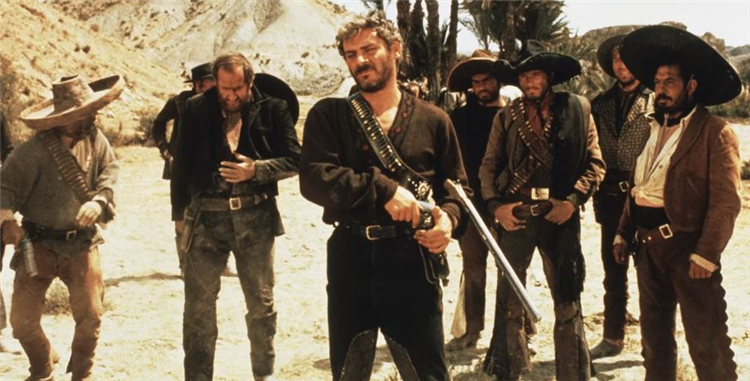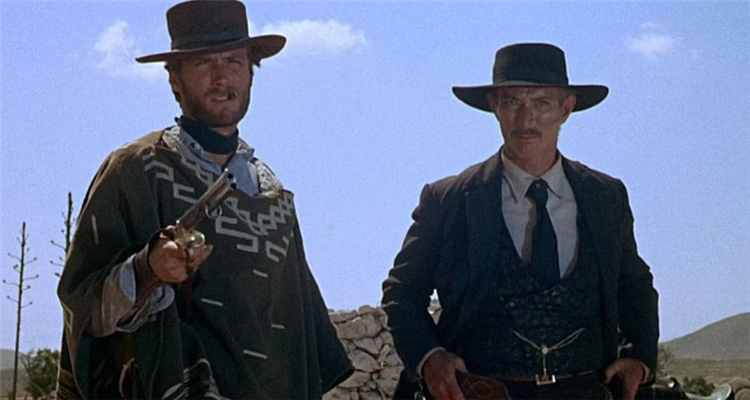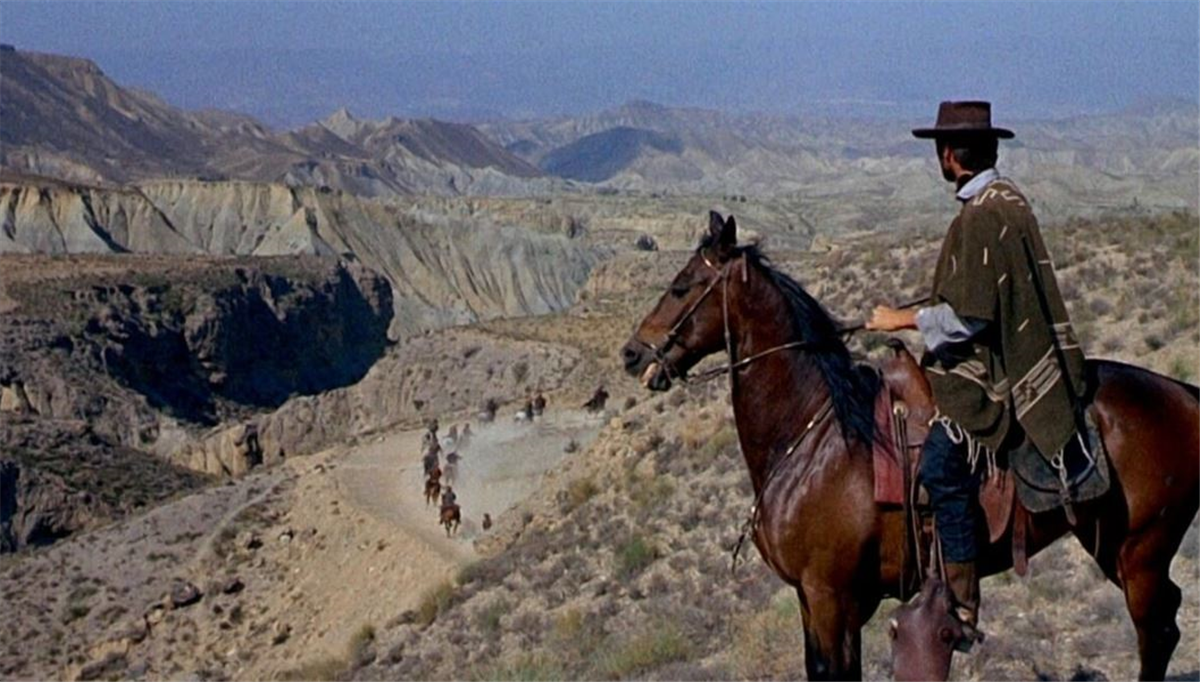For a Few Dollars More (1965) begins with a lone rider on the twilit plain somewhere in America. A shot rings out, and the rider’s limp body falls from the horse. Leone’s grim, prefatory joke is a strikingly crass reminder — for those who may have forgotten the central conceit of A Fistful of Dollars (1964) — that life is worth only as much as the bounty ascribed to it. A hand-drawn gale whips across the cracked earth, forming the block-lettered credits, accompanied by Ennio Morricone’s score (possibly the best of the trilogy, certainly the boldest), gravely sparse with jaw harp and whistle, peppered with gunshots. Leone took a shoestring budget and made a masterpiece of anarchic fury, so he’s done something quite extraordinary for a few dollars more.
Before the bloody meal begins, an epigraph: “Where life had no value, death, sometimes, had its price. That is why the bounty killers appeared.” The first bounty killer, or hunter, we meet is Lee Van Cleef’s Colonel Douglas Mortimer. He sits with a Bible splayed before him, suggesting a desire to travel undisturbed rather than an interest in scripture. More importantly, as we will see, Colonel Mortimer’s personal code is all that matters; Leone’s world is far too cruel to take a hobbyist interest in invisible, forsaking forces.
We’ve hardly spent more than a few minutes with Colonel Mortimer when his burlap saddle bag unfurls, revealing an impressive array of killing machines, including a Colt Buntline Special to which he adds a ridiculous stock for long-range attacks. Needless to say, the pistol is put to effective use, and Colonel Mortimer collects a bounty. The mustachioed Man in Black, cunning Lee Van Cleef, forms one-third of the film’s triumvirate.
Next, we meet Manco (Clint Eastwood), Spanish for “one-handed,” branded as the Man with No Name for publicity purposes, although he was previously referred to as “Joe” in A Fistful of Dollars. Eastwood’s Joe in the previous entry hardly had a modicum of amiability; Manco is an even less inviting version of the same character, saying less and doing more with arched eyebrows than most people do with Shakespeare. As his name suggests, Manco only uses his left hand, grabbing lapels and socking saloon-goers while the other arm rests under his poncho. Only when the pursuit of a bounty requires shooting, which it invariably does, will Manco use his other hand. The results are spectacular, shorn to essential movements: the hand comes out; victims fall dead where they stand.
For a Few Dollars More is the Most Underrated Sergio Leone Film
Sandwiched between two highly regarded classics, For a Few Dollars More is a stunning standout worth revisiting

The most crucial factor of For a Few Dollars More is the third character we meet, El Indio (Gian Maria Volonté), who has an unheard-of $10,000 bounty on his head. When we happen upon him, he is imprisoned, sleeping under a sombrero, waiting for his cronies to break him out. They do, of course. The ensuing breakout is peppered with wanton violence aimed toward his captors and even a sorry sap who abetted El Indio’s escape. El Indio goes on the lam, smoking weed and hatching schemes that would seem harebrained had he not been played by the wild-eyed Volonté. Beneath shrouds of smoke and a tousled gray mop, there’s a calculating brain with enough gusto — and creepy henchmen, including Klaus Kinski as a hunchback — so that the plan to rob the bank of El Paso just might work. As El Indio runs from the past (all will be revealed, rest assured), he is charting a predestined course that will lead him right into the paths of Colonel Mortimer and Manco.
Where A Fistful of Dollars offered a Spaghetti pastiche of Akira Kurosawa’s Yojimbo (1961), here, the remix is chopped and screwed further with aspects of Kuwabatake Sanjuro’s strategic mind being dispensed amongst three agenda-driven individuals. The story, however, is a wholly original concept and remarkably complex. Each character’s desires and vastly different methods of approach are highlighted as the separate paths briefly converge, meeting in mutually beneficial arrangements (and as fate ordains) before spinning out again to wander the Wild West.
With hardly a paragraph’s worth of background information, the three characters at the film’s center are vividly realized. We understand everything we need to know about these men through actions or the loaded pauses between actions when thoughts materialize in facial contortions. Van Cleef, Eastwood, and Volonté are three of the best faces ever to grace the silver screen. We know what’s coming well before the pieces are placed for the final showdown, for the darting glances tell us much more in nearly imperceptible movements in plot and depth than any number of exposition-addled action films. Talk, like life in Leone’s films, is cheap.

For a Few Dollars More is bookended by two films that have received more attention in the past 60 or so years (give or take). Not just chronologically but stylistically, this abutted masterpiece bears the hallmarks of its forebear and signals the changes Leone would make in later works. Leone’s crisp, desolate imagery, born of necessity, remains the strength of these films, with some of the most striking close-ups offered in this middle sibling. Take, for instance, the scene in which El Indio’s men are casing the Bank of El Paso while Colonel Mortimer is sizing up the crooks. Meanwhile, across the way, Manco observes Colonel Mortimer through binoculars. For a scene composed primarily of faces observing their surroundings, the meticulousness is anything but soporific; it’s downright invigorating.
For many of Sergio Leone’s fans, The Good, the Bad and the Ugly marks the moment that the operatic became mythological. But all of the elements were present in For a Few Dollars More, which is taut as a garrote and moves with the conviction of the stone-cold killer. If The Good, the Bad and the Ugly is the grand pronouncement of an artist in full command of his powers, this film serves as our informal farewell to a scrappier, grimier, though no less alluring filmmaker. Leone would push the boundaries of palpable temporality further in his next film and, eventually, in Once Upon a Time in the West (1969). Still, the unremitting passage of time is present throughout this entire trilogy.
For those who have yet to see For a Few Dollars More, it’s easy to guess what the story entails in its bare movements. These films, starkly realized as if carved in stone, have embedded themselves within our cultural memory and sense of Wild West narratives. What makes them great, particularly For a Few Dollars More, are the details beyond the plot — the ways each performer navigates the well-trod terrain. Through gestures, small exchanges, and cool demeanor, this film invites us to look at a living, breathing world where fate brushes against individual wills and bulldozers any sense of hope. In the land of criminals and bounty hunters, the only winner is the one fortunate enough to lick their wounds and ready themselves for their subsequent trial.
